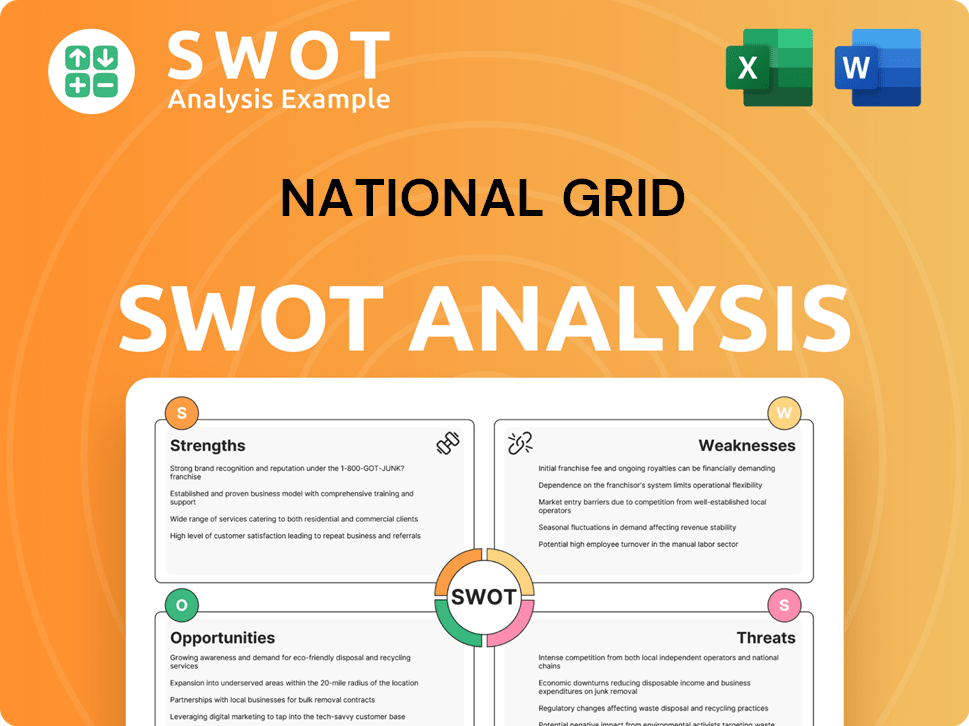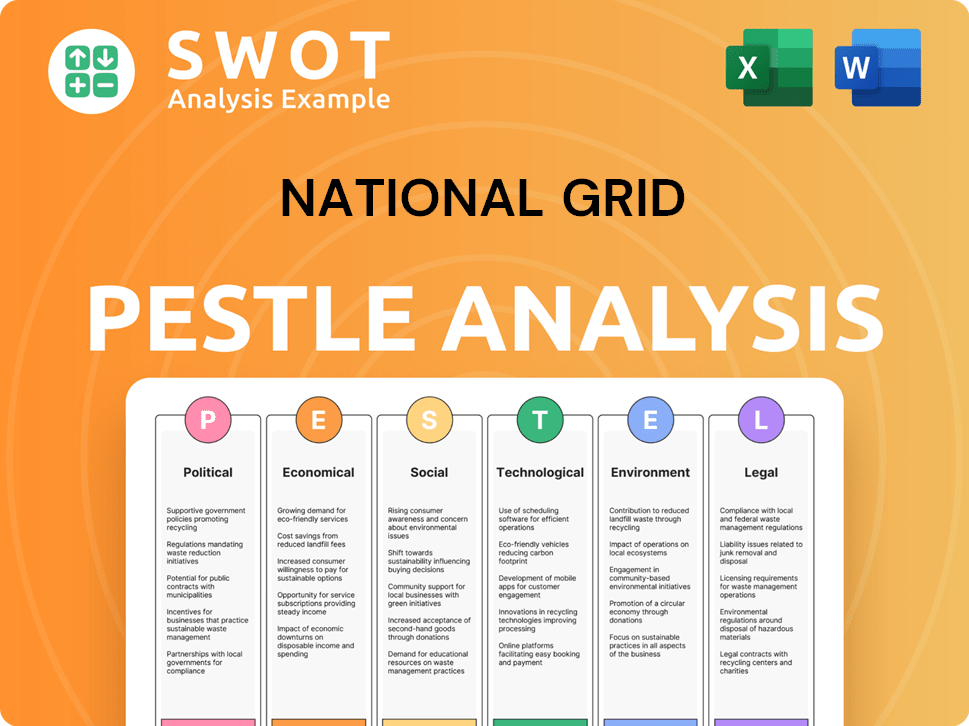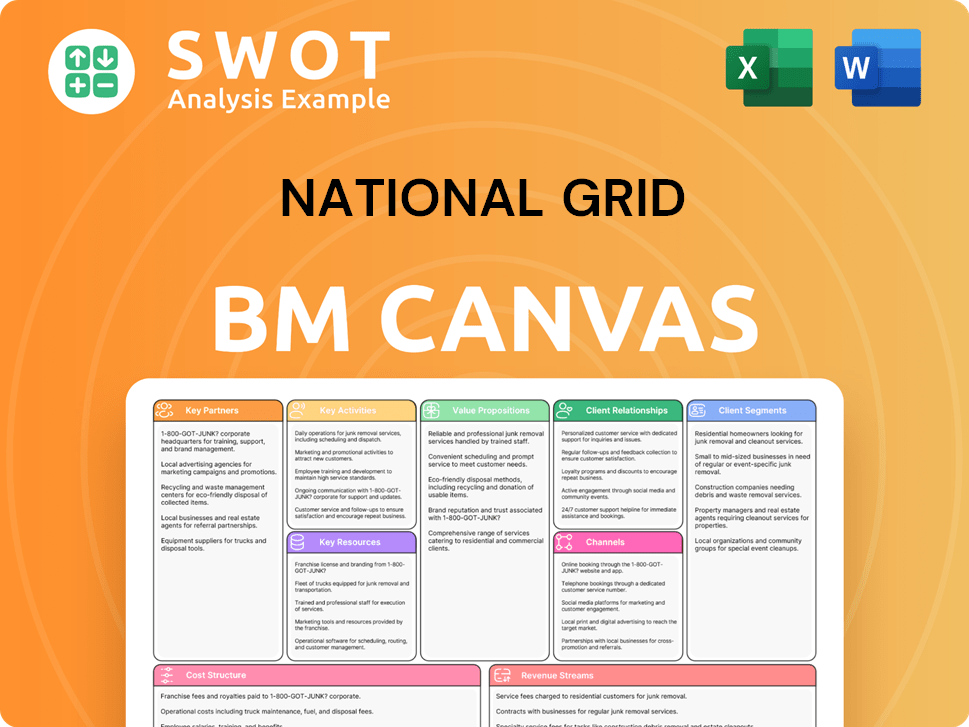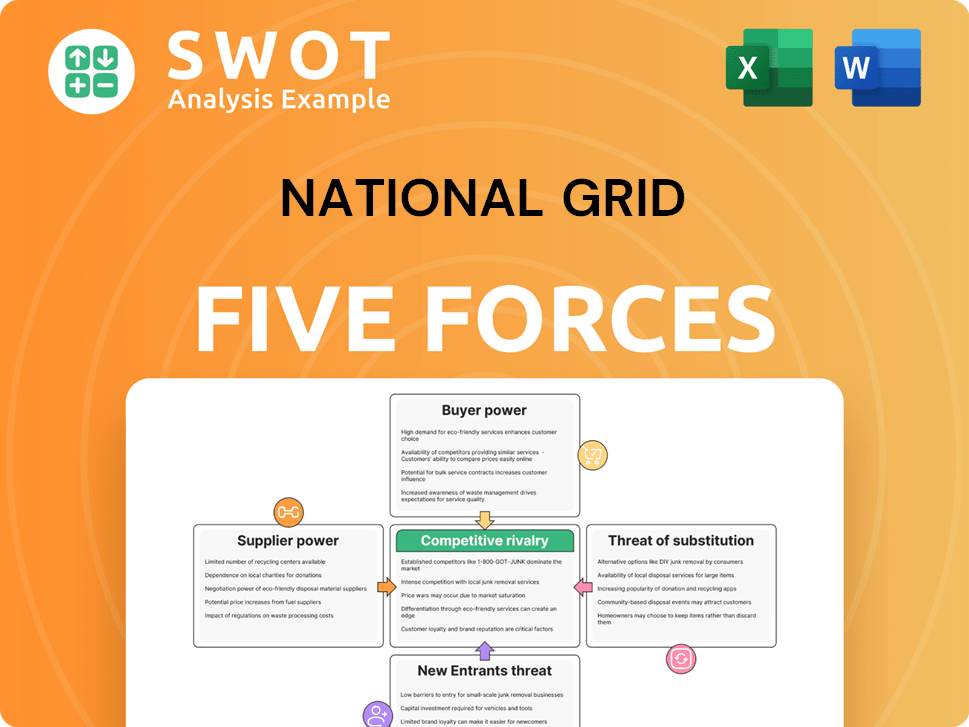National Grid Bundle
Who Really Controls National Grid?
Unraveling the question of "Who owns National Grid company?" is key to understanding its vast influence in the energy sector. This British multinational giant, a cornerstone of the UK and US energy infrastructure, has a fascinating history rooted in the privatization of the Central Electricity Generating Board. Its strategic direction and future investments are deeply impacted by its ownership structure.

From its humble beginnings to its current status as a global utility powerhouse, National Grid's ownership has evolved significantly. The National Grid SWOT Analysis reveals the internal and external factors that shape its strategies. Understanding the National Grid shareholders and their influence provides crucial insights into the company's operational strategies and governance. This exploration delves into the company's ownership history and structure, offering a comprehensive view of this critical energy provider, including its major shareholders and how to invest in National Grid.
Who Founded National Grid ?
The formation of the National Grid Company plc in 1990 marked a pivotal moment in the UK's energy sector. The company emerged from the Central Electricity Generating Board (CEGB), taking over its transmission activities. Initially, the ownership structure was unique, reflecting a transition from state control to a more market-oriented model.
The initial ownership of the National Grid was vested in the twelve regional electricity companies (RECs). These RECs collectively owned National Grid through a holding company, National Grid Group plc. This structure was a direct result of the privatization of the UK's electricity industry, setting the stage for the company's future development.
The early ownership of the National Grid was not based on individual founders or angel investors. Instead, it was established through a government-led privatization process. The RECs, already existing entities, became the initial shareholders, shaping the company's foundational structure.
The initial ownership was held by the twelve regional electricity companies (RECs).
The company's genesis was through a government-led privatization.
Listed on the London Stock Exchange in December 1995.
The IPO broadened the shareholder base to include private investors.
The RECs' vision was a unified national electricity transmission system.
The IPO marked a significant shift in ownership.
The initial public offering (IPO) in December 1995 was a turning point for the National Grid ownership structure. The IPO allowed the company to move beyond the original ownership by the RECs and opened the door for broader public investment. This transition to a publicly listed entity introduced a more diverse shareholder base, including institutional and individual National Grid investors. For further insights into the competitive landscape, consider exploring the Competitors Landscape of National Grid . As of early 2024, the company continues to be a key player in the energy sector, with its National Grid shareholders including a mix of institutional investors and the public.
National Grid SWOT Analysis
- Complete SWOT Breakdown
- Fully Customizable
- Editable in Excel & Word
- Professional Formatting
- Investor-Ready Format

How Has National Grid ’s Ownership Changed Over Time?
The evolution of National Grid's ownership has been marked by significant milestones since its initial listing on the London Stock Exchange in December 1995. As of June 13, 2025, the company's market capitalization stood at approximately $70.59 billion USD. The ownership structure reflects a diverse range of investors, including institutional and retail investors.
Key events have reshaped the company's ownership landscape. In January 2002, the company acquired Niagara Mohawk Power Corporation. The merger with Lattice Group in October 2002 formed National Grid Transco plc, consolidating UK gas and electricity transmission businesses. More recently, the company has been strategically divesting its gas assets, including the sale of its final 20% holding in National Gas, with the divestment expected to complete in the first quarter of 2025. This follows the sale of a 60% stake in its UK gas transmission and metering business in January 2023 and an additional 20% stake in July 2023. These moves are part of a strategic shift toward a greater focus on electricity, with the company's asset base expected to be around 80% electric by 2028/29, up from 60% in 2021. For more insights, you can explore the Brief History of National Grid .
| Shareholder | Shares Held (as of March 31, 2025) | Percentage of Outstanding Shares |
|---|---|---|
| Vanguard Total International Stock Index Fund | 68.61 million | 1.40% |
| Income Fund of America | 58.4 million | 1.19% |
| iShares Trust-iShares Core MSCI EAFE ETF | 31.09 million | 0.63% |
As of March 31, 2025, institutional investors collectively held 65.39% of the shares. Major institutional shareholders include The Vanguard Group, Inc., which held 191.04 million shares as of May 1, 2025, representing 3.91% of shares held by top holders. Other significant holders include JPMorgan Investment Management, Inc., Legal & General Investment Management Ltd., and BlackRock Advisors (UK) Ltd.
National Grid's ownership structure is diverse, with significant holdings by institutional investors.
- The Vanguard Group is a top shareholder.
- The company has undergone strategic shifts in its asset base.
- Divestments in gas assets are ongoing.
- Institutions held 65.39% of shares as of March 31, 2025.
National Grid PESTLE Analysis
- Covers All 6 PESTLE Categories
- No Research Needed – Save Hours of Work
- Built by Experts, Trusted by Consultants
- Instant Download, Ready to Use
- 100% Editable, Fully Customizable

Who Sits on National Grid ’s Board?
The Board of Directors at the National Grid company oversees the company's strategic direction and management, representing the interests of its shareholders. As of June 2025, the board is chaired by Paula Rosput Reynolds, with John Pettigrew serving as Chief Executive Officer and Executive Director. Andrew Jonathan Agg holds the position of Chief Financial Officer and Executive Director. The board typically includes a mix of experts relevant to National Grid's operations, including representatives from major shareholders and independent directors. Understanding the structure of Who owns National Grid is key to understanding its governance.
The board's composition reflects a commitment to diverse expertise, crucial for navigating the complexities of the energy sector. While specific board members representing individual major shareholders aren't always itemized in public disclosures, the influence of large institutional investors is often seen through their engagement with the board and management. This structure ensures that the interests of National Grid shareholders are considered in key decisions, contributing to the overall stability and strategic vision of the company. For more information on the company's strategic direction, see Growth Strategy of National Grid .
| Board Member | Position | As of |
|---|---|---|
| Paula Rosput Reynolds | Chair of the Board | June 2025 |
| John Pettigrew | Chief Executive Officer and Executive Director | June 2025 |
| Andrew Jonathan Agg | Chief Financial Officer and Executive Director | June 2025 |
The voting structure for National Grid ownership is based on a one-share-one-vote principle. As of March 31, 2025, there were 4,897,123,773 shares carrying voting rights, which shareholders use to calculate their interests under the Financial Conduct Authority's (FCA) rules. In January 2025, the company issued 6,006,065 ordinary shares through its Scrip Dividend Scheme, bringing the total ordinary shares to 5,132,617,708, with 4,892,176,696 shares carrying voting rights. American Depositary Share (ADS) holders generally have the same voting rights as underlying shareholders, provided they give instructions to the depositary. Recent disclosures in April 2025 show share transactions by key managerial personnel.
The Board of Directors at National Grid is led by Paula Rosput Reynolds as Chair and John Pettigrew as CEO.
- Voting rights are based on a one-share-one-vote system.
- As of March 31, 2025, there were nearly 4.9 billion shares with voting rights.
- Recent transactions by key personnel have been disclosed.
- The company maintains transparency in voting rights and managerial share transactions.
National Grid Business Model Canvas
- Complete 9-Block Business Model Canvas
- Effortlessly Communicate Your Business Strategy
- Investor-Ready BMC Format
- 100% Editable and Customizable
- Clear and Structured Layout

What Recent Changes Have Shaped National Grid ’s Ownership Landscape?
Over the past few years, the ownership of the National Grid company has undergone significant changes. A notable event was the Rights Issue in May 2024, which aimed to raise approximately £7 billion by issuing new shares. This capital was earmarked for a substantial increase in energy network infrastructure investment, totaling around £60 billion between FY2025 and FY2029. This offering represented about 29.2% of the then-current share capital.
The National Grid ownership structure has also seen strategic divestitures. The company completed the sale of its final 20% equity interest in National Gas Transmission in March 2024. Additionally, the UK government acquired the electricity system operator (ESO) license in October 2024 for £630 million, establishing the National Energy System Operator (NESO). Further, in February 2025, an agreement was reached to sell the National Grid Renewables US onshore renewables business to Brookfield Asset Management for an enterprise value of $1.735 billion, with completion expected in the first half of the financial year ending March 31, 2026. These moves reflect a strategic shift towards focusing on core electricity and gas networks, with expectations that the asset base will be approximately 80% electric by 2028/29, compared to 60% in 2021.
| Development | Date | Details |
|---|---|---|
| Rights Issue | May 2024 | Raised approximately £7 billion through new share issuance. |
| Sale of National Gas Transmission | March 2024 | Sold final 20% equity interest. |
| Acquisition of ESO License | October 2024 | UK government acquired the license for £630 million. |
| Sale of Renewables Business | February 2025 | Agreement to sell US onshore renewables business for $1.735 billion. |
Industry trends have also influenced National Grid shareholders. Institutional ownership has increased, holding 65.39% of shares as of March 31, 2025. The company continues its scrip dividend scheme, allowing shareholders to receive new shares instead of cash dividends, with 6,006,065 ordinary shares issued in January 2025 for the 2024/25 interim dividend. Further insight into their approach can be found in the Marketing Strategy of National Grid .
Rights Issue in May 2024 raised £7 billion.
Sale of National Gas Transmission and Renewables businesses.
Increased institutional ownership, reaching 65.39%.
Shift towards core electricity and gas networks.
National Grid Porter's Five Forces Analysis
- Covers All 5 Competitive Forces in Detail
- Structured for Consultants, Students, and Founders
- 100% Editable in Microsoft Word & Excel
- Instant Digital Download – Use Immediately
- Compatible with Mac & PC – Fully Unlocked

Related Blogs
- What are Mission Vision & Core Values of National Grid Company?
- What is Competitive Landscape of National Grid Company?
- What is Growth Strategy and Future Prospects of National Grid Company?
- How Does National Grid Company Work?
- What is Sales and Marketing Strategy of National Grid Company?
- What is Brief History of National Grid Company?
- What is Customer Demographics and Target Market of National Grid Company?
Disclaimer
All information, articles, and product details provided on this website are for general informational and educational purposes only. We do not claim any ownership over, nor do we intend to infringe upon, any trademarks, copyrights, logos, brand names, or other intellectual property mentioned or depicted on this site. Such intellectual property remains the property of its respective owners, and any references here are made solely for identification or informational purposes, without implying any affiliation, endorsement, or partnership.
We make no representations or warranties, express or implied, regarding the accuracy, completeness, or suitability of any content or products presented. Nothing on this website should be construed as legal, tax, investment, financial, medical, or other professional advice. In addition, no part of this site—including articles or product references—constitutes a solicitation, recommendation, endorsement, advertisement, or offer to buy or sell any securities, franchises, or other financial instruments, particularly in jurisdictions where such activity would be unlawful.
All content is of a general nature and may not address the specific circumstances of any individual or entity. It is not a substitute for professional advice or services. Any actions you take based on the information provided here are strictly at your own risk. You accept full responsibility for any decisions or outcomes arising from your use of this website and agree to release us from any liability in connection with your use of, or reliance upon, the content or products found herein.